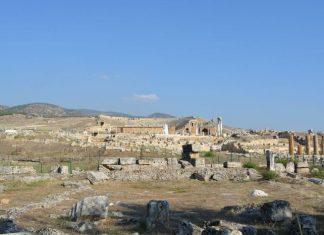His world was full of good barbarians and bad barbarians. Roman forces—or, to be more precise, the forces that Rome paid—were fading away, leaving flourishing towns to struggle just to maintain law and order. When the story ended and the people who loved Severinus fled to Italy in 488, they did not flee barbarian invasion but left behind a breakdown of law and order. Before that happened, a group of good soldiers went off to Italy to retrieve their pay and their colleagues, but they were ambushed and lost along the way—unbeknownst to anyone except Severinus, who broke off reading one day in his cell to weep for them. His followers rushed to the river to see it running with blood, and then to see the bodies of the soldiers washed ashore. They hadn’t gotten far.
In this world of fading power, Severinus became the new figure of authority—an authority that earthly disasters could not undermine. He encouraged people and they were cured; he chastised people and they changed their ways; he knew things at a distance and people were left in awe. Every story of a holy man needs a miracle here and there, but his miracles are paltry. For example, at one point he asked everyone to bring a candle to church, and then revealed that the ones whose candles wouldn’t light worshipped false gods. Followers gradually clustered around him and he built a monastery, but he kept a private hermitage as well rose festival tour.
The good barbarian king Flaccitheus
The good barbarian king Flaccitheus, leader of the Rugi people across the Danube, maintained warm relations with the holy man until his daughter-in-law tried to rebaptize catholic Christians—for she was probably an Arian—and Severinus raised his voice to get her to cease, as she apparently did, at least for a time. Odoacer’s appearance introduces his followers to this account, from a people called the Heruls who liked to serve in the Roman army. Other Heruls would wind up fighting for Constantinople’s generals Belisarius and Narses inside Rome’s world; still others fought for Rome against barbarians in Hungary and were destroyed for their pains; the last of them faded to the north and disappeared from history not long after.
Rescuing captives, everyday business when you live among warlords, was part of the holy man’s job. After rescuing one man, Severinus sent him back across the Danube on market day to look for another particular man, whom Severinus described in detail, even his clothing and where in the market to find him. When found, the second man beseeched his new friend to take him to the man of God, offering any price for the favor. He turned out to be carrying relics of saints Gervasius and Protasius, the same saints whose bodies Ambrose had discovered in a conveniently anti-Arian moment in Milan 100 years earlier.31 Severinus was happy to receive saints who had confounded Arians, and he put them in his basilica along with the relics of many others. Relics of John the Baptist, no less, would join them not long after, coming not from the Holy Land far to the east but from across the Danube—barbarian territory, but not without its powerful saints.
Severinus’s most impressive miracle has the weakest attestation, and the beneficiary rejected it. He successfully prayed to bring a priest who had died back to life, only to have the priest complain: “By the Lord I beg you, don’t hold me here longer or cheat me of the eternal rest I had begun to enjoy.” And he then fell asleep again in death. The subdeacon Marcus and the doorkeeper Maternus kept this story secret until after Severinus’s death, for they had sworn to the holy man that they would not reveal it while he was alive; they then passed it along to Eugippius.
Read More about Constantinople with the traditional insignia







